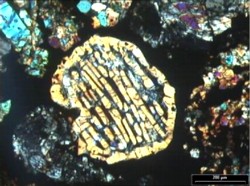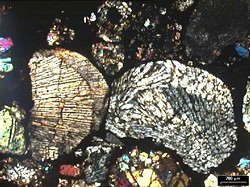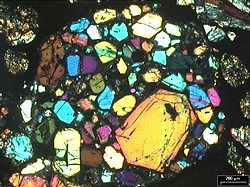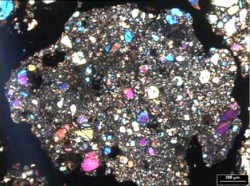Meteorite image gallery
Return to course homepage.
Chondritic meteorites

Handspecimen of Murchison (CM2 chondrite).
In this agglomeratic rock, chondrules and
CAIs (the lighter objects) are set in dark,
carbon- and water-rich fine-grained matrix.
Orange areas were stained by terrestrial weathering.
From: http://www.meteorlab.com/METEORLAB2001dev/murchy.htm
Images obtained in cross-polarized light of different chondrule types
(barred olivine--upper left; two radial pyroxene chondrules--
upper right;
porphyritic olivine-- lower left; granular to microporphyritic
olivine-- lower right).
Scalebars are 200 microns long.
From: http://lexikon.astronomie.info/meteorite/chondrite.html
DAG 632
(LL3) chondrite |
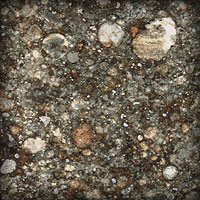 |
DAG 860
(LL4) chondrite |
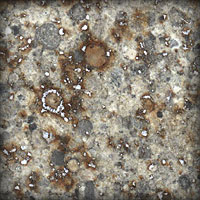 |
DAG 633
(LL5) chondrite |
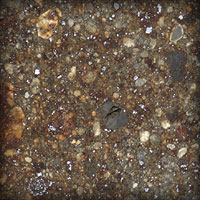 |
Acfer 354
(LL6) chondrite |
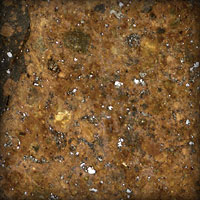 |
Sequence of images illustrating metamorphism
of chondrites using LL meteorites recently collected
in Northwest Africa as an example. All pictures
were obtained in reflected light of polished
surfaces. Reddish stains were produced during
terrestrial weathering.
From: http://www.saharamet.com/meteorite/gallery/chondrite/index.html
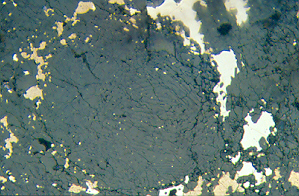
Metal (white) and sulfide (yellow) rim around
a large chondrule in the Yafa (H5) chondrite,
viewed in reflected light. Image is 2.5
mm wide.
From: http://www.physics.utoronto.ca/~isotrace/yafapix2.htm
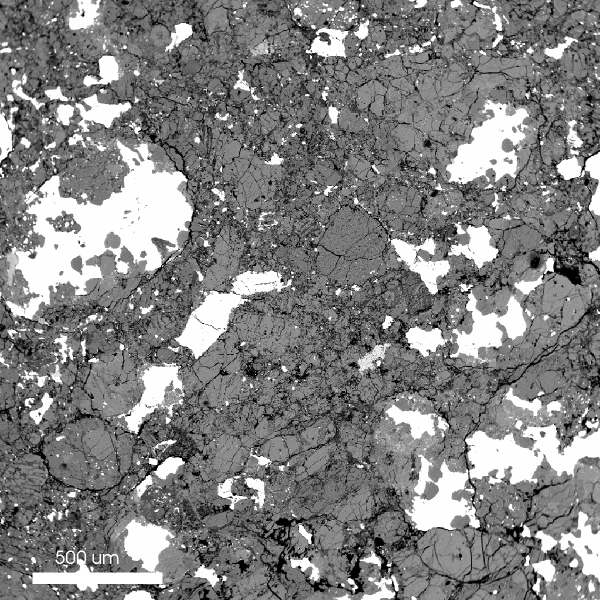
Typical area of a metamorphosed ordinary chondrite (St. Robert H5
chondrite)
seen on a polished surface in reflected light. Metal and sulfide
appears bright, silicates grey,
and cracks black. Metamorphism has not fully obscured the
original chondrule-matrix texture.
From: http://castaing.eps.mcgill.ca/meteoriteposter/poster.html
Achondritic meteorites
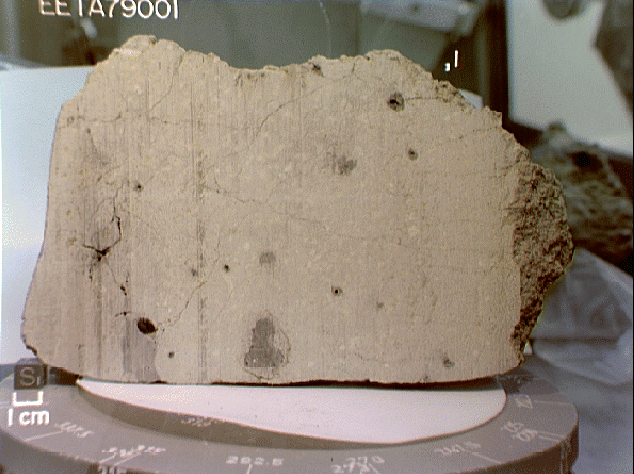
Cut face of SNC meteorite EETA79001, a basaltic shergottite.
Impact melt glass (dark) was
produced during the impact event which lofted the rock off its parent
body. Small amounts of gas
from an atmosphere on the parent body were trapped in the melt glass
and provide compelling
evidence that this and other SNC meteorites originated on Mars.
Note the overall grey or tan color
of the specimen, which is unlike the orange-tinted and probably
weathered materials seen in
spacecraft images of the martian surface.
From: http://www.solarviews.com/cap/meteor/martian.htm
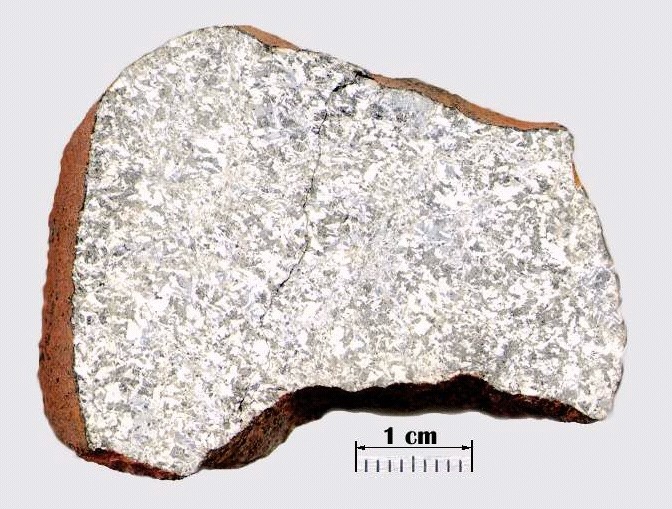
Cut and polished face of a sample of the Millbillillie eucrite,
a basaltic achondrite of the HED family
probably derived from asteroid 4-Vesta. White areas are plagioclase,
and grey areas are clinopyroxene.
The reddish rind was produced by terrestrial weathering of the original
fusion crusted surface.
From: http://www.astrosurf.com/lombry/meteorites3.htm
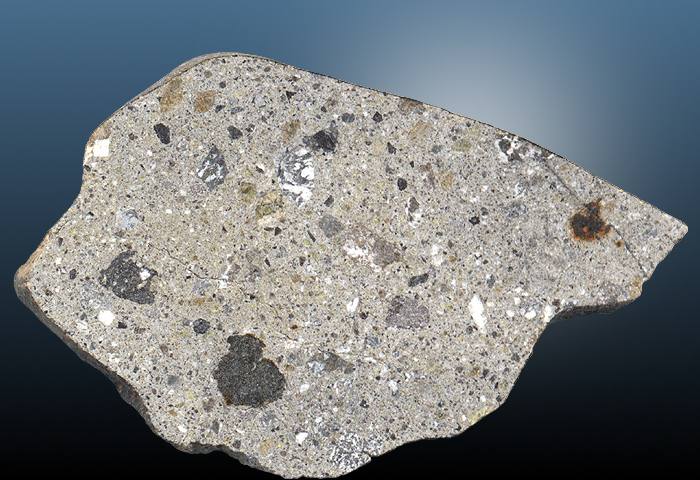
Cut and polished face of the DAG 844 howardite, a polymict breccia
of the HED family consisting mainly
of eucrite and diogenite (green & brown-colored orthopyroxene)
clasts. Of all meteorites, howardites best
match the overall mineralogy of the surface of asteroid 4-Vesta.
The specimen shown above is 4.5 x 3 cm across.
From: http://www.saharamet.com/meteorite/gallery/HED/
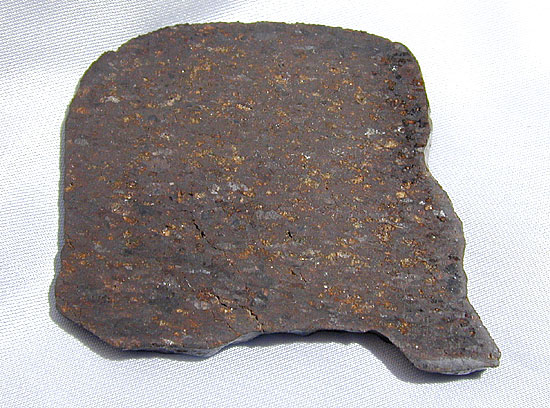
Slice of the DAG 485 ureilite. Ureilites consist chiefly of
millimeter-sized olivine crystals
(visible as brownish-green areas in the image), together with a
C-rich groundmass and
smaller amounts of pyroxene (mainly pigeonite). No scale was
given for the image
above, but I'd guess the sample is ~10 cm across.
From: http://www.nyrockman.com/museum/dag485-38.2.htm
Iron meteorites
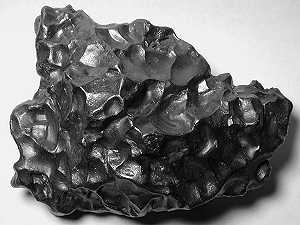
Specimen of the Sikhote-Alin (IIAB) iron meteorite,
showing well developed regmaglypts. A shower of
fireballs produced hundreds of impact holes and thousands
of individual rocks.
From: http://www.meteorlab.com/METEORLAB2001dev/sikhote.htm
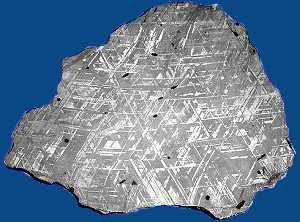
Cut and etched surface of Gibeon (IVA), showing
Widmanstatten texture.
From: http://www.meteorlab.com/METEORLAB2001dev/widpatrn.htm
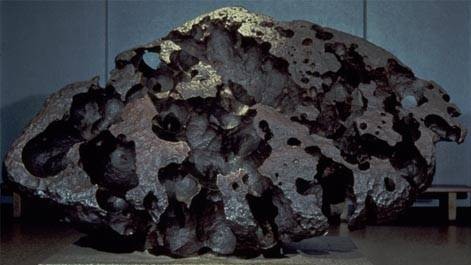
Willamette iron meteorite (IIIAB), which at 15 tons is the largest
meteorite
recovered in the U.S. It was found in what is now West Linn.
The large depressions were caused by terrestrial weathering.
From: http://www.astrosurf.com/lombry/meteorites3.htm
Stony-iron meteorites
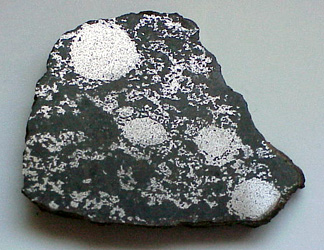
Polished slice of the Morristown mesosiderite showing
metal (bright) and silicate (dark). In mesosiderites,
the silicates are dominated by metamorphosed clasts
of basalt, gabbro, plagioclase, and pyroxene, mainly
derived from the upper portion of a differentiated
asteroid. The metal appears to have been derived from
the core of a possibly different asteroid. The specimen
above measures 10 x 7.5 cm across. A somewhat
unusual feature of this particular specimen is the
clumping of metal into clast-like objects.
From: http://www.star-bits.com/morristown.htm
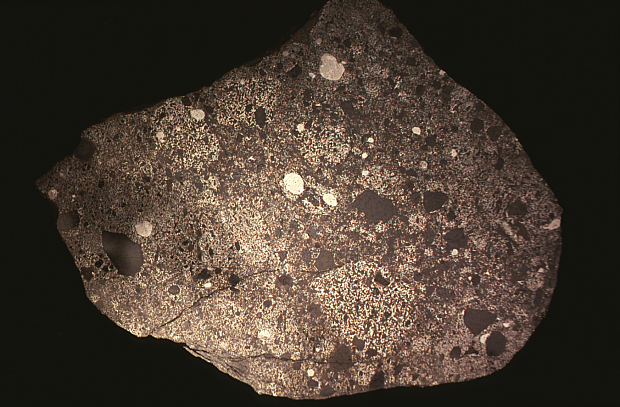
Cut and polished face of the Mt. Padbury mesosiderite showing clasts
of silicate (dark), metal
(light), and mixtures of silicate and metal. Mesosiderites
are good examples of polymict breccias,
with clasts having been derived from a variety of lithologies.
No scale was given for the above
image, but I'd estimate the sample to be ~25 cm across.
From: http://www.nmnh.si.edu/minsci/images/gallery/26.htm
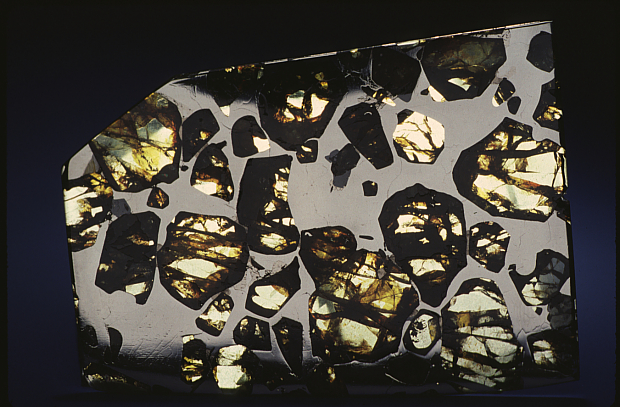
Cut and polished face of a thin slice of the Esquel pallasite.
In pallasites, olivine is enclosed by
Fe-Ni metal. The slice above is cut sufficiently thin that
olivine is partly transparent. Pallasites
probably formed at the core-mantle boundary of a differentiated
asteroid. No scale was given
for the above image, but I'd estimate that the sample is ~5-8 cm
across.
From: http://www.nmnh.si.edu/minsci/images/gallery/10.htm

